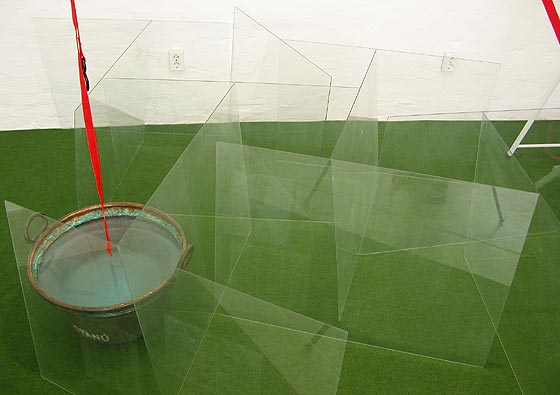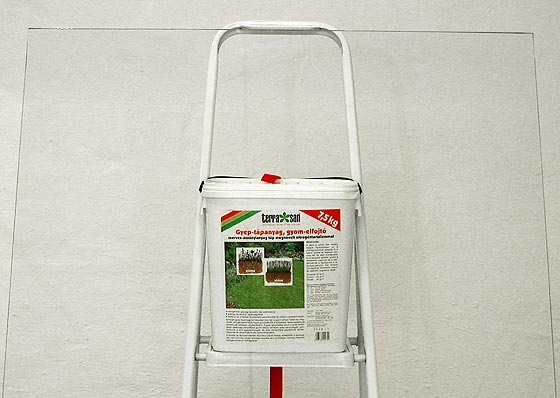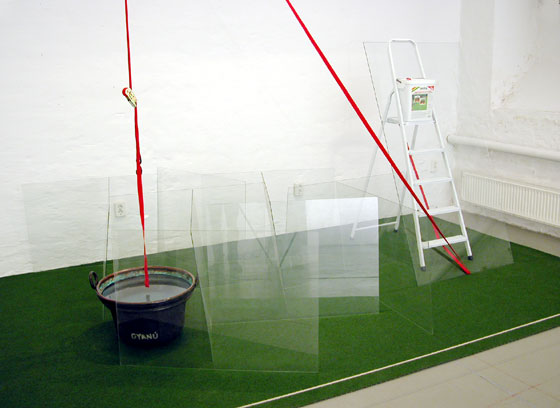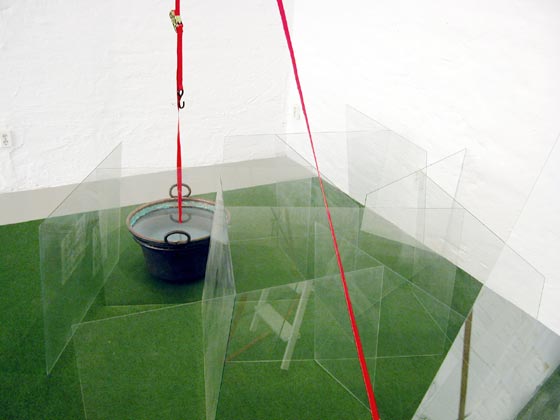Crystals of Libel, (blood is thicker than water)
Tricolour, (the homeland is up high)
György Galántai: ... the Crystals of Libel – Tricolour permutation was conceived during the development of the reconstruction plan made in 2005 for Miklós Erdély’s installation titled Crystals of Libel, One Should Think about Artificial Fertiliser (1981).
Another implementation of the above reconstrution at the Műcsarnok/Kunsthalle was prevented by several interlinked financial factors as well as by an ideological problem. The authentic reconstruction of the original project was hindered by the fact that none of the original objects were preserved and their acquisition was made impossible by the radical changes that had taken place in the material and technological culture in the 25 years that passed. Moreover, the social as well as the philosophical and aesthetic circumstances had also changed considerably.
Artificial fertiliser should not be,
moreover, cannot be thought about as previously.
In other words, this work – in regard to its variables – is obsolete.
However, the work has a constant,
which can be rebuilt using other variables,
i.e. it can be permutated.
The constant element of the composition derives from the
material and formal connections that link the meanings
of the words combined in the title: libel and crystal.
Libel is a false statement damaging one’s honour; it is an unfounded accusation,
and its motive is blatantly obvious, i.e. transparent,
since it doesn’t contain any elements relevant to the one the libel is addressed to.
The transparent quality of the glass plate refers to this notion.
Quartz sand is one of the important raw materials used in glass production. Quartz is a component element in numerous eruptive rocks as well as crystalline slate. After these rocks wear away, the tiny quartz crystals get into the rivers and seas, which then wash some of the little quartz grains, by then more or less worn round by the water, on the shore in the form of sand.

The authenticity of the permutation is provided by materials and objects – purchasable meanings – which were available in the consumer society’s retail selection at the time and had the potential to be part of a magical interaction.
The ‘variable’ selected as the starting point is the artificial fertiliser (műtrágya), which ironically sounds very similar to artwork (műtárgy), in the Hungarian language and therefore had to occupy this same position in the permutation; in other words, it has to play a defining role in the self-assembling ensemble of objects. Hence, the artificial fertiliser is the first product that should be selected in a shop where every material and object imaginable is available.
Initially, the artificial fertiliser and the five-rung ladder were engaged in a dialogue of forms, but then the type of artificial fertiliser and the colour of the plastic container (white) definitively determined the mutant elements and new meanings of the construction being built. The modern, multifunctional artificial fertiliser – lawn feed and herbicide –, i.e. green, the colour of hope, replaced the sad sight of the tarpaper on the floor – there is no other option..

The black twine (black line) which, in 1981, started out from the pane of glass covering the artificial fertiliser and the five-rung ladder and after spanning the ‘crystals of libel’ was hanging in the tar-making vat, thus conveying Miklós Erdély’s doubt, fell victim to a paradigm shift in regard to its material and colour. It was replaced by a red strap (red line), and the colour of this highly durable strap provides the top colour of the Hungarian tricolour.
The last black element – the tar-making vat – was also replaced by a very old family copper caldron, which was once used to make jam in. This is the only element not purchased from a shop, and as such highlights the transitory aspect of the shop-bought construction, while the green colour of its surface, oxidised by the thermal water it holds, reinforces the colour of hope.

DOUBT:
The thermal water in the caldron (saturated solution) was dissolved from crystals from Sárvárand it is hoped that it will exert a magical effect upon the crystals of libel.
The subtitles in brackets correspond to the popular commercial visual world of shops, while the well-known, cliché texts inserted in brackets combined with the non-bracketed titles and the visual correspondences together create a hidden but all the more powerful telematic and ambiguous semantic field.
Crystals of Libel (blood is stronger than water)
Yes – those who libelled; why would they change.
No – those who didn’t libel; why would they change.
The line of power and ‘blood’ (red) starts here and now from the colour of hope, i.e. from the lawn feed and herbicide ‘programme’, while white (loyalty) rises high in the background and being reflected in the water in the caldron it continues as a green line, thus attesting to the truth of the statement. (see also: the yes and the no)
Tricolour (the homeland is up high)
The line of power, the red strap (red line) rises up high in the white background and being reflected in the water in the caldron (green line) continues into the ca. 2,000-metre-depth of the thermal water. Viewed from here, from the ground (green), the statement that I, or you – i.e. the homeland – is/are up high now seems true.
György Galántai: „Loyalty”
(Supplement to the permutation titled Crystals of Libel – Tricolour)
Some related ‘telematic semantic fields’:
György Galántai | Loyalty 2004 |
National Ladder 1993–2003 |
Tricolour Stamp 1976
Miklós Erdély: Crystals of Libel,
installed and dismantled
Hidden Green | Tricolour | Apocryphal Lecture | Mineral Wool | My Golden Fascists





